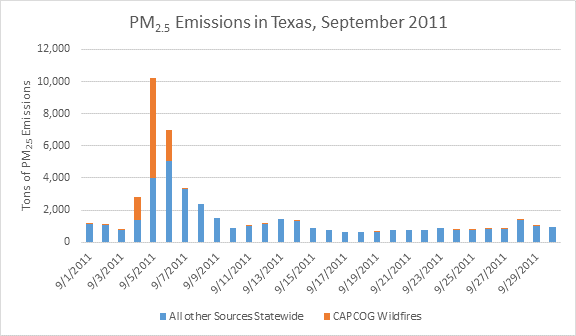Wildfires and Smoke
While wildfires are not frequent in the area, when they do occur, it’s important to understand the magnitude of the potential public health impacts from the fires. Smoke from agricultural burning and trash burning can be harmful to your health, too.
Check out AirNow's Fire and Smoke map to see current levels of fine particulate matter (PM2.5) pollution, locations of wildfires and prescribed burns, and smoke impacts from these fires.

Wildfires and Public Health
One of the hazards of wildfires that can often be overlooked is the air pollution and the health impacts of that pollution. A conservative estimate of the public health impact from wildfires emissions suggests that there was a $500 million public health impact from increased PM2.5 and ozone concentrations due to the September 2011 wildfires in the Central Texas region beyond the $325 million in property damage.
Learn More about Widfires
While wildfires are not frequent in the area, when do occur, it’s important to understand the magnitude of the potential public health impacts from the fires too, and to take steps to both minimize the risks of wildfires and ensure that schools, nursing homes, and health-care providers get timely information about wildfires and smoke plumes when they do occur and to account for air pollution impacts from wildfires when emergency managers conduct planning for how to address wildfires.
Be Air Aware and be “Fire-Wise” by learning how to help reduce the risks of wildfires: http://www.firewise.org/?sso=0
Data sources:
2011 Texas Wildfires report by Texas A&M Forest Service (for info on the wildfires)
EPA 2011 Emissions Inventory (for daily emissions totals during 2011)
Estimating the Benefit per Ton of Reducing PM2.5 Precursors from 17 Sectors (for estimates of the public health impact/ton of NOX, SO2 and PM2.5 emissions on PM2.5 concentrations)
Regulatory Impact Analysis of the Final Revisions to the National Ambient Air Quality Standards for Ground-Level Ozone (used to calculate the ozone public health impact/ton of NOX emissions)
CPI Inflation Calculator (used to calculate the ozone public health impact/ton of NOX emissions)
Smoke Pollution
Wildfires can produce a lot of smoke. Fine particles, called “particle pollution” ot PM2.5, are the pollutant of most concern in wildfire smoke. These microscopic particles can get deep into your lungs. They can cause many health problems from burning eyes and runny nose to aggravation of chronic heart and lung disease, leading to emergency department visits, hospital admissions and even premature death. Anyone with heart and lung disease is especially at risk. While not everyone reacts the same way to wildfire smoke, it’s always a good idea to reduce your exposure to smoke.
If you live in or near wildlands, contact the Texas A&M Forest Service for up-to-date information on wildfire risk. Remember, smoke can travel to locations far away from fires, so it is good to know how to reduce your smoke exposure wherever you are. Being prepared is especially important for people with heart or lung disease, older adults and children.
Here are some ways to get ready for fire season:
Talk to your health care provider if you have heart or lung disease. Ask what you should do during wildfire smoke events and have a plan to manage your condition. The Environmental Protection Agency and Centers for Disease Control and Prevention have an online course, Particle Pollution and Your Patients’ Health for medical professionals (physicians, nurses, and health educators) that covers particle pollution and health, and offers continuing education credits.
Know how you will get emergency alerts and health warnings. Check the AirNow website and the AirNow Fire and Smoke Map for the latest outdoor air quality information.
Stock up on food, medicine, and other essentials so you don’t have to go out when it’s smoky. Have enough medication on hand to last several days. Buy groceries that do not need to be refrigerated or cooked. Frying and broiling can add to indoor air pollution.
More Fire Tools
- AirNow Fires Page - Info on current wildfires, wildfire resources, fires and your health resources
- Prepare for Fire Season Factsheet - Learn how to protect your health from wildfire smoke.
- Indoor Air Filtration Factsheet
- Reduce Your Smoke Exposure Factsheet
- Protect Your Lungs from Wildfire Smoke or Ash
- Protect Yourself from Ash
- Protecting Children from Wildfire Smoke and Ash Factsheet
Learn more about the fire managers who help communities understand and respond to air quality impacts from fire and smoke.
How can I get my home ready?
When it’s smoky outdoors, try to stay indoors. Remember, smoke from outside can enter your home and affect the indoor air quality as well. Here’s how you can prepare:
Buy a portable air cleaner before there is a smoke event. Make sure it does not make ozone and it is the right size for the room where you plan to use it.
Ask a heating, ventilation and air conditioning (HVAC) professional what kind of high efficiency filters (rated MERV 13 or higher) you can use in your home’s HVAC system. Learn how to close the fresh-air intake if your HVAC system or room air conditioner has one.
Learn how to create a “clean room” in your home where you can shelter in place. Choose a room with no fireplace and as few windows and doors as possible, such as a bedroom, where you can shelter in place. Plan to use a portable air cleaner in the room.
Organize important items you may want to take with you if you evacuate, like financial and personal documents.
What if I need to go outside?
In smoky situations, spend as little time outside as you can. If you must go outside, here’s what you can do:
Wear a NIOSH-approved respirator, such as an N95 respirator. (If you have one, may not be available due to COVID-19) They can be helpful in reducing exposure to smoke if you take care to follow instructions on how to properly wear a respirator. N95 respirators are sold at many home improvement stores and online. Information about respirator use is available in the factsheet, Protect Your Lungs from Wildfire Smoke or Ash.
Take it easier during smoky times to reduce how much smoke you inhale. If it looks or smells smoky outside, avoid strenuous activities such as mowing the lawn or going for a run.
Use the recirculate mode in your car’s air conditioner.
How can I protect my animals?
 Your pets and livestock can be affected by smoke. Keep them healthy by avoiding smoky areas and limit physical activity. New factsheets about protecting pets and protecting livestock, developed with the American Veterinary Medical Association, offer guidance for protecting your pets and large animals.
Your pets and livestock can be affected by smoke. Keep them healthy by avoiding smoky areas and limit physical activity. New factsheets about protecting pets and protecting livestock, developed with the American Veterinary Medical Association, offer guidance for protecting your pets and large animals.
How can I protect myself from ash from the smoke?
Thoroughly clean yourself with soap and water as soon as possible. Ash may contain a variety of chemicals that could irritate exposed skin.
Wash any vessels or utensils used for food preparation or consumption. These should be cleaned prior to use if there is a possibility that they are contaminated.

2011 Bastrop Fires
Wildfires in the Central Texas region on September 5, 2011, accounted for 21% of all nitrogen oxides (NOX) emissions statewide, 33% of all volatile organic compounds (VOC) emissions, and 61% of all fine particulate matter (PM2.5) emissions.
In September 2011, sparks from damaged power lines ignited a wildfire that would become the most destructive wildfire in Texas history. The Bastrop Complex Fire, which burned from September 4, 2011 – October 10, 2011, claimed 2 lives, caused $325 million in damage, including destroying over 1,600 homes and 40 commercial structures. Over 34,000 acres in Bastrop County, scorching more than 6% of the total land area of the county. Across the state, a total of 4,064 fires burned 300,279 acres during September 2011.